Google Business Profile for Medical Practices: A Beginner's Guide
Patients find healthcare providers through Google Business Profile listings. Our article provides best practices for managing all listings for...
Learn the best methods for using social posts in your Google Business Profile.
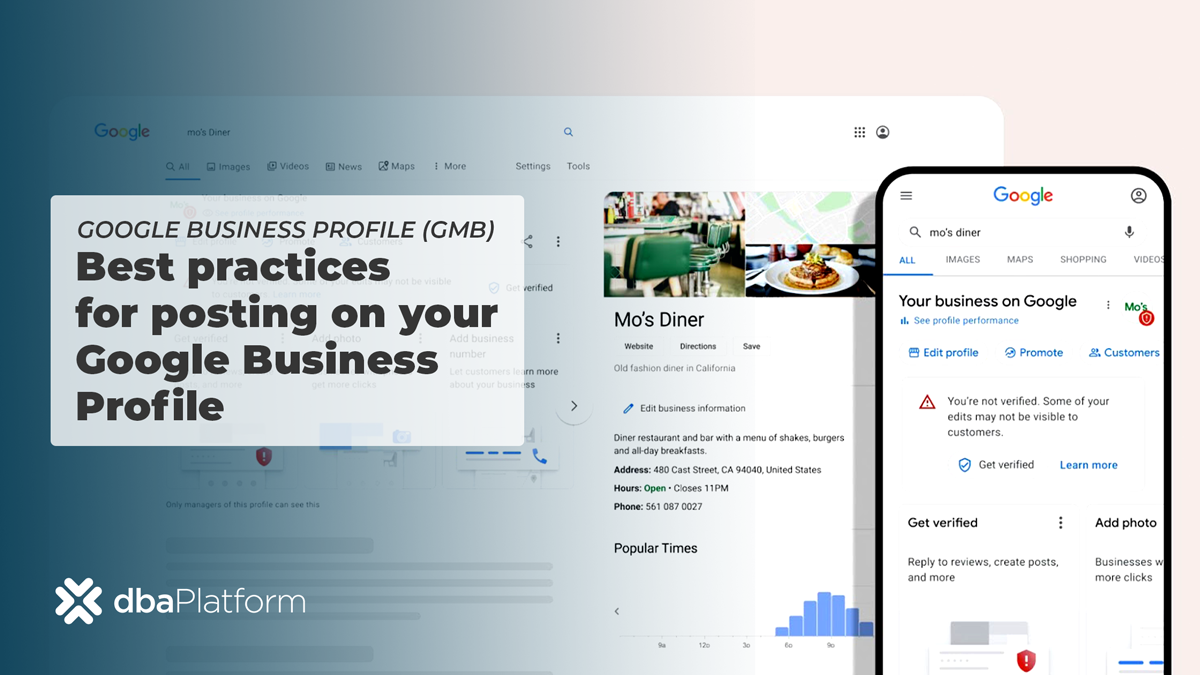
Did you know that posting on your Google Business Profile can positively affect your profile’s overall visibility? Posting can help optimize Business Profiles if used strategically. While business posts look and feel like other social media platforms’ content, don’t be deceived. Their nature, purpose, and behavior vastly differ from other social posts.
Posts are located in the business’ Google Business Profile. Here’s how a user comes across them:
1.) In a Google search for “tires,” the map section presents tire service shops.
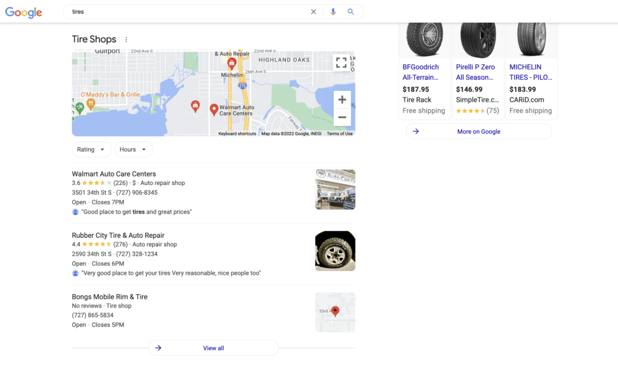
2.) The user clicks on the “Tires Plus” option, and then the screen expands (the blue arrow and box depicts the “Google Business Profile” for Tires Plus):
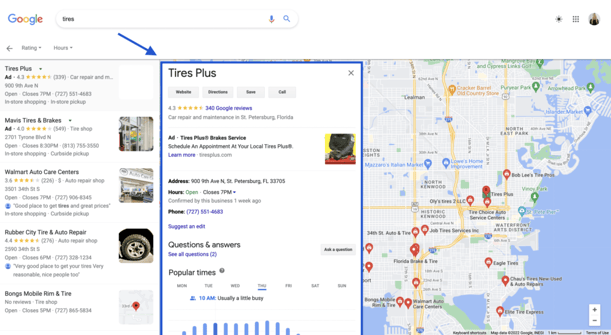
3.) To see a post in this profile, the user must scroll to the bottom of the profile. The user will then see the post section of the profile, which will look like the example below
Note: there’s one post and then a button to see the history of posts:

In the Tires Plus case, they haven’t posted in the last week, so the profile has a post section, but NO posts are currently visible:
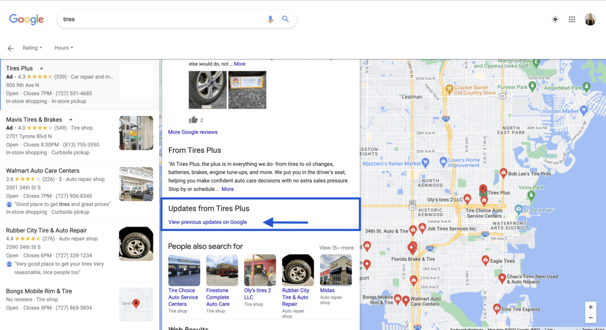
If the user clicks through to see previous posts, they’ll get a limited scrolling history which looks like this:
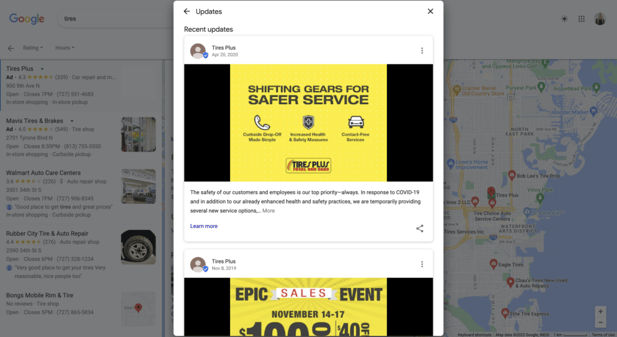
Bottom line: The post section has a value, and it’s not to keep in touch. It’s to add conversion information to the profile when consumers dig deep to learn about a business.
Reviewing the difference between the posts featured in Google Business Profiles and those found in the traditional social media models will aid in examining the difference between the two.

Static vs. Changing – There are only so many strong messages that tip the balance in your favor. Find eight of the strongest, most compelling, convincing messages and stay with them. Variety is not the strategy in Google Business Profile posts. In the days of the consumer “Yellow Pages,” AAA Plumbing would keep a static ad that described the best features and a call to action.
Business Profile posts should provide a little more flexibility than a Yellow Pages ad, but the point is that when finding a solid message, stay with it and convert active prospects.
A solid posting strategy for your Google Business Profile increases the profile’s local authority in several ways:
– Regular posting demonstrates activity and updates to the profile, which boosts the profile’s relevancy in the search engine’s formula and
– The post’s content (such as an offer or highlighting a little-known service) creates a conversion point that lures the prospect deeper into the sales funnel. Posts mainly feature two types of consumer content: prospect conversion and customer updates.
Prospect conversion – the main focus of a profile post is to promote special offers to move a prospect closer to a buying behavior (just like an ad). Since the Google Business Profile appears after a search query, the content posted to a profile is considered top of the funnel marketing activity (seen by new prospects).
Compare that to traditional social media like Facebook, which is viewed as a nurture strategy lower in the marketing funnel, and you’ll find that the content strategy is quite different.
Once an ad/offer post converts, please don’t change it. Try testing new variations, but keeping the post the same will allow new prospects to see specific information in a certain order. Unlike Facebook posts, where the content varies widely and is presented in no particular order, Google business posts cycle through a small number of conversion-focused messages.
Additionally, the profile automatically removes the posts after seven days. There’s no scrolling history of what was posted previously, meaning a business can confidently re-post their best content over and over for all the fresh prospects coming through your funnel.
Customer Updates – occasionally, established consumers will search a business on Google, so use the post space to provide essential updates like changes in holiday hours or upcoming events. The pandemic is an excellent example of the need to broadcast changes in business operations, and businesses from all industries used the profile posts to communicate new programs like curbside pickup options, etc.
The best starter strategy for posting is to optimize and re-use approximately 8-12 posts, not counting any seasonal or special events that a business may want to promote. Experts agree that there is no penalty for reusing content, that well-structured offers rarely need refreshing, and profiles attract new prospects every day who require the same messaging- not new, not fancy. After all, business cards or signage isn’t created new every day.
Display in the Three Pack – If written content in posts matches a search query used by someone using Google, there’s a chance that those keywords will be pulled into the search result and presented to the user. This placement is called a ‘justification,’ and there are various types.
This is what a post justification would look like:
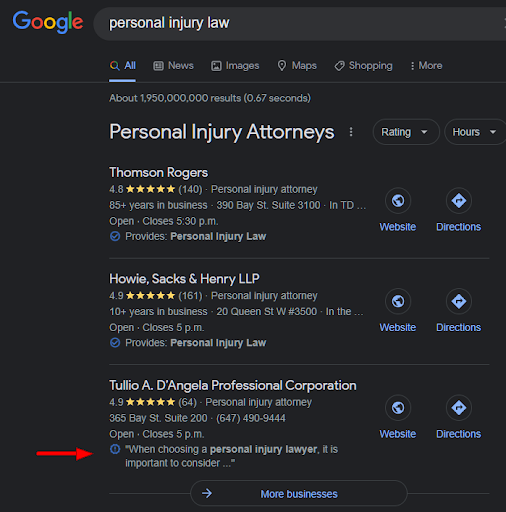
Fresh content is way more important at the bottom of the funnel when nurturing a relationship and keeping customers informed between purchases. Fresh content is also important where subscribers and visitors can see the whole repository of a brand’s content and judge whether they have a lot or lack content. For example, a YouTube channel with three old videos doesn’t reflect well on educational efforts. However, at the top of the funnel, when a consumer sees an ad on the side of a bus, they don’t wonder if there are new brand messages underneath that one.
Once per week is sufficient. Posting more often to a listing buries previous content and diminishes engagement potential on each post. If posting occurs less than once a week, posts will be moved off the profile, and the updates section will be empty, representing a missed opportunity.
(Some posts types stay pinned to the profile longer, but the general rule of thumb is once per
week.)
Best post types differ by industry, but once a winning conversion message is identified, stick with it. In general special offers, event information, and new product offerings work well.
A post will receive twice as many clicks when it has a title that is upper/lower case. Use emojis and photos with text. Original photography works better than stock photos.
Try these tactics:
Learn which posts work best for your business profile and stick with them. Test, refine, and repost 8-12 of your most successful and relevant posts.
Patients find healthcare providers through Google Business Profile listings. Our article provides best practices for managing all listings for...
In the spirit of transparency and forcing businesses to address suspensions correctly, Google has rolled out a new reinstatement process for...
Go beyond the basics of Google Business Profile Q&A.